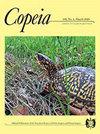评估滕明基迪特雷马的生殖策略和女性贝特曼梯度:父亲的数量与配偶的数量是一个很好的近似值吗?
IF 2.6
Q2 Agricultural and Biological Sciences
引用次数: 1
摘要
冲浪鱼科(Embiotocidae)是一个独特的胎生鱼类科,具有内部受精、妊娠至亚成年阶段和活产;因此,孕产妇投资极高。这引发了一种期望,即窝的大小是有限的,雌性应该挑三拣四,选择很少的配偶。然而,迄今为止,在所有八个被检查的物种中都发生了多重亲子关系,其高患病率在92–100%之间。大多数冲浪栖息动物都分布在东太平洋海岸,但蒂米特雷马分布在西太平洋,我们发现它们与其他冲浪栖息动物的交配策略不同。在坦明克氏锥虫中,多重亲子关系的患病率仅为60%。此外,平均每窝父系数量仅为1.86只,尽管窝数在12-15只之间,而且亲子关系存在偏差,大部分亲子关系分配给一只雄性。我们认为,这些差异可能与该物种对雄性的强烈雌性选择有关。最后,我们评估了父亲的数量是否是对配偶数量的准确估计,方法是通过对子宫囊内精子的等位基因进行基因分型,将从子女中父亲身上检测到的等位病毒数量与配偶身上的等位抗体数量进行比较,没有发现显著差异,这表明父系数量是对坦明氏D.minckii配偶数量的合理估计。本文章由计算机程序翻译,如有差异,请以英文原文为准。
Evaluating Reproductive Strategies and Female Bateman Gradients in Ditrema temminckii: Is the Number of Fathers a Good Approximation for the Number of Mates?
Surfperches (Embiotocidae) are a unique family of viviparous fishes that have internal fertilization, gestation to the sub-adult stage, and live-birth; therefore, maternal investment is extremely high. This invokes the expectation that brood size is limited and females should be choosy and select few mates. Yet multiple paternity occurs in all eight species examined to date, with high prevalence ranging from 92–100%. Most surfperches are found along the Eastern Pacific coast, but Ditrema temminckii is distributed in the Western Pacific and we found differences in their mating strategy compared to other surfperches. In D. temminckii, prevalence of multiple paternity was only 60%. Further, the average number of sires was only 1.86 per brood even though brood sizes ranged from 12–45, and paternity was skewed, with the majority of paternity allocated to a single male. We propose that these differences may be associated with strong female selection on males in this species. Finally, we evaluated whether the number of fathers is an accurate estimate for the number of mates by comparing the number of alleles detected from fathers within the brood to the number of alleles from mates via genotyping alleles from spermatozoa within the uterine sac and found no significant difference, suggesting that the number of sires is a reasonable estimate for the number of mates in D. temminckii.
求助全文
通过发布文献求助,成功后即可免费获取论文全文。
去求助
来源期刊

Copeia
生物-动物学
CiteScore
2.10
自引率
0.00%
发文量
0
审稿时长
6-12 weeks
期刊介绍:
Founded in 1913, Copeia is a highly respected international journal dedicated to the publication of high quality, original research papers on the behavior, conservation, ecology, genetics, morphology, evolution, physiology, systematics and taxonomy of extant and extinct fishes, amphibians, and reptiles. Copeia is published electronically and is available through BioOne. Articles are published online first, and print issues appear four times per year. In addition to research articles, Copeia publishes invited review papers, book reviews, and compiles virtual issues on topics of interest drawn from papers previously published in the journal.
 求助内容:
求助内容: 应助结果提醒方式:
应助结果提醒方式:


